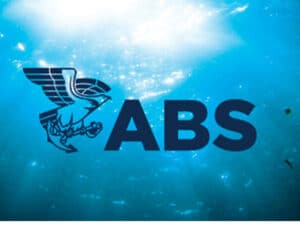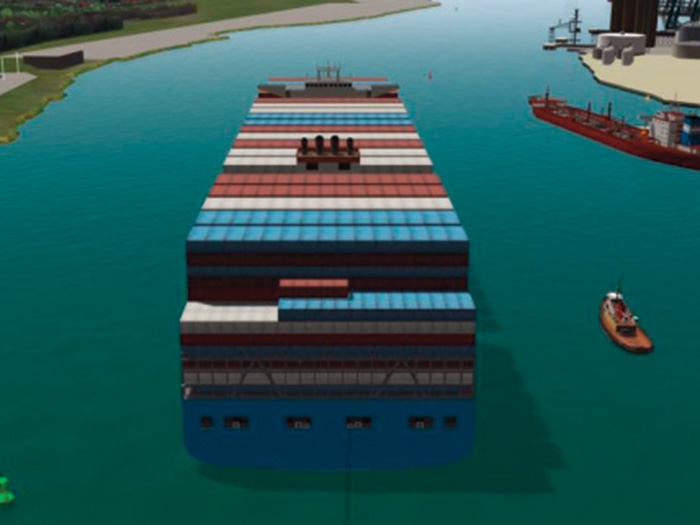
What’s needed to bring ULCVs into New York?
Written by Nick Blenkey
MARCH 9, 2017 — The Port of New York and New Jersey is getting set to receive the new generation of higher ultra-large container vessels (ULCV). The controlling depth of the major navigation channels has now been increased to 50 feet at MLL water. And the raising of the Bayonne Bridge is expected to be completed this year.
To identify the best practices for the safe and efficient handling of ULCV transits to the major container terminals in the port, Major stakeholders felt it vital to conduct full-mission ship simulation studies.
The simulations were conducted at the Maritime Institute of Technology and Graduate Studies (MITAGS) in Linthicum Heights, MD, in two phases during the second half of 2016:
Phase I: Evaluated 14,000 TEU MSC Kalina Class vessel (maximum LOA 366 m X beam 51 m). Phase II: Evaluated the 18,000 TEU Maersk Triple E Class vessel (maximum LOA 399 m X beam 59 m).
The MITAGS simulators are capable of providing the most realistic presentation in the world. The theater projection area is more than 24 meters wide and 12 meters high. This provides unsurpassed depth perception and visual accuracy.
The full mission ship simulator was operated by pilots from the Sandy Hook Pilots Association, Metro Pilots, and McAllister Harbor Pilots and integrated with one assist-tug simulator operated by an experienced tug master. Additional tugs were operated from the console.
The simulations showed that both 14,000 and 18,000 TEU class vessels can be safely handled in the port with certain parameters in place.
GENERAL FINDINGS
- Two pilots required at all times: a Sandy Hook pilot and docking pilot.
- Minimum visibility of 1.5 miles required at Bergen Point.
- Maximum sustained wind of 20 knots. May be adjusted over time with more experience.
- Transit within one hour either side of slack water at Bergen Point.
- Speed limited to 5 knots or less when passing vessels alongside terminals in the Elizabeth Channel and Port Jersey Channel.
- No bunker barges alongside vessels in Elizabeth and Port Jersey channels when other ULCVs are transiting.
- No meeting/passing in Kill Van Kull except for agreed upon situations with vessels under 500 feet.
TUGBOAT REQUIREMENTS
- Inbound: two (2) tractor tugs meet at the Narrows Inbound Port Jersey: three (3) to four (4) tugs as necessary
- Inbound Kill Van Kull: three (3) to four (4) tugs as necessary
- Inbound/outbound Elizabeth Channel: four (4) tugs (2 tractor, 2 conventional)
ELIZABETH CHANNEL AND PORT JERSEY CHANNEL
Elizabeth Channel: When (un)docking, it is difficult to navigate between two (2) 18,000 TEU class vessels docked directly across the channel from each other. Also, it is preferred to have cranes boomed up for passage.
Port Jersey Channel: When (un)docking, only one (1) moored vessel can be at the entrance to channel at a time (Public Berth or Cape Liberty Cruise Terminal). Also, surge may impact passenger and stores operations.
ADDITIONAL REQUIREMENTS
- Before getting underway from Ambrose, must have confirmation that the transit inbound and designated berth is clear.
- On time movement is essential. Delays on outbound ULCVs will be problematic.
- All cranes must be positioned amidships and bunched or moved completely out of the way and not moving into position as ship is approaching or departing the designated berth.
- Coordination among all inbound and outbound ships, the terminals they are calling and other ships scheduled to transit is critical.
- Continuous and quality communications are necessary.
- ULCVs cause significant surging effect to moored vessels. Lead lines and bollard strength must be sufficient for safe passage of ULCVs.
NOTE: The parameters for vessels less than 10,000 TEU have not changed. As pilots gain more experience in handling ULCVs, some of these parameters may be adjusted.





Leave a Reply
You must be logged in to post a comment.